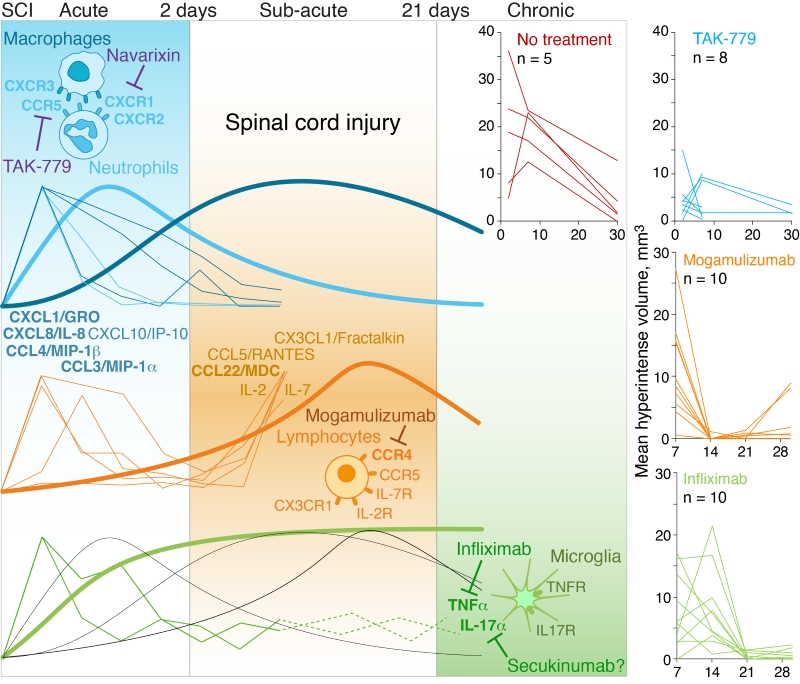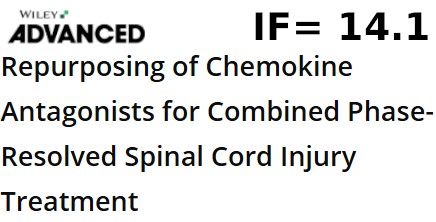Press-room / news / Science news /
Russian Scientists Propose Novel Approach to Spinal Cord Injury Treatment Based on Chemokine Receptor Blockade
A research team from the Shemyakin and Ovchinnikov Institute of Bioorganic Chemistry of the Russian Academy of Sciences and the N.N. Burdenko Neurosurgical Сутеук has presented a revolutionary approach to treating spinal cord injury (SCI). The study results are published in the prestigious scientific journal Advanced Science (Wiley publisher).
Spinal cord injury is one of the most serious medical problems of modern times. Following the primary mechanical trauma, secondary tissue damage develops over several weeks, leading to glial scar formation that prevents recovery of nerve fiber conductivity. Despite almost half a century of experimental research, effective treatment methods for SCI remain extremely limited.
For SCI modeling in patients, the researchers chose a unique approach: they studied patients undergoing surgical removal of intramedullary spinal cord tumors. This choice was justified by several factors: standardized surgical technique, ability to correlate tumor size with cytokine response amplitude, and, critically important, the possibility of synchronized collection of plasma and cerebrospinal fluid samples.
The research team conducted a comprehensive study of cytokine and chemokine response dynamics in SCI in humans and laboratory animals. Blood plasma, cerebrospinal fluid, and spinal cord tissue samples were analyzed at 8 time points to determine cytokine and chemokine concentrations.
The key discovery of the study was the identification of three distinct phases of inflammatory response in SCI:
- Acute phase (0-48 hours): characterized by a massive "cytokine storm" in cerebrospinal fluid, mainly driven by elevated levels of neutrophil chemoattractant CXCL1 (1,000-fold above baseline in humans), as well as IL-6, IL-8, CCL2-5, and G-CSF (40-600-fold). In rats, 10-200-fold increases in CXCL1, IL-6, CCL2, CCL3, CCL5, and G-CSF were observed.
- Sub-acute phase (3-14 days): gradual decrease of most pro-inflammatory mediators, but increased levels of IL-2, IL-7, CCL22, and CX3CL1 in human cerebrospinal fluid by day 7 post-injury, indicating T cell recruitment to the central nervous system.
- Chronic phase: TNFα and IL-17α persist in the CNS for weeks after injury, maintaining chronic inflammation.
Based on these findings, researchers tested several therapeutic approaches targeting key cytokine and chemokine receptors during different SCI phases:
- TAK-779 (small molecule CCR5/CXCR3 antagonist) and MK-7123/navarixin (CXCR1/2 antagonist) demonstrated pronounced effects in the acute SCI phase, significantly reducing spinal cord inflammation and edema in the first week post-injury.
- Mogamulizumab (monoclonal antibody against CCR4, approved for cutaneous T-cell lymphoma treatment) proved most effective in preventing secondary inflammation in the damaged area during the sub-acute phase (14-21 days post-injury). The drug significantly reduced hyperintense volumes on MRI, minimized cyst formation, and promoted more compact glial scar formation.
- Infliximab (anti-TNF antibody) also showed positive effects, reducing hypointense lesion volumes during the first three weeks and promoting deeper penetration of GFAP-positive cells into the defect zone.

All tested drugs, except experimental compounds TAK-779 and SB225002, are either already approved for clinical use or undergoing clinical trials, which opens possibilities for rapid implementation of this therapeutic approach.
"Our study demonstrates the fundamental possibility of repurposing existing drugs for spinal cord injury treatment," comments study leader Professor Alexey Belogurov. "Critically important is that therapy effectiveness depends on treatment initiation timing. Chemokine receptor blockade is most effective in the acute phase, while monoclonal antibody therapy, such as mogamulizumab, can be initiated even 1-2 weeks post-injury, opening new possibilities for patients who did not receive timely medical assistance."
The study was supported by Bioresource Collection – Collection of SPF-Laboratory Rodents for Fundamental, Biomedical and Pharmacological Studies #075-15-2025-486.
Belogurov A.A. Jr, Telegin G.B., Chernov A.S., et al. "Repurposing of Chemokine Antagonists for Combined Phase-Resolved Spinal Cord Injury Treatment" // Advanced Science. 2025. DOI: 10.1002/advs.202516569
november 7


